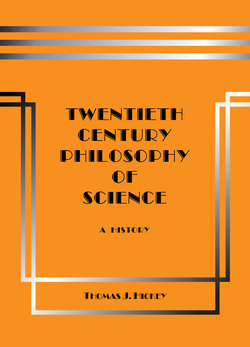Читать книгу Twentieth-Century Philosophy of Science: A History (Third Edition) - Thomas J. Hickey - Страница 36
На сайте Литреса книга снята с продажи.
3.05 Syntactical Rules
ОглавлениеSyntax is a system of symbols. Therefore in addition to the syntactical symbols and structures, there are also rules for the system called “syntactical rules”. These rules are of two types: formation rules and transformation rules.
Formation rules are procedures described in metalanguage that regulate the construction of grammatical expressions out of more elementary symbols.
Formation rules order such syntactical elements as mathematical variables and operator signs, descriptive and syncategorematic terms, and the user-defined variable names and reserved words of computer source codes. Expressions constructed from the symbols in compliance with the formation rules for a language are called “grammatical” or “well formed formulas”, and include the computer instructions called “compiler-acceptable” and “interpreter-acceptable” source code.
When there exists an explicit and adequate set of syntactical formation rules, it is possible to develop a type of computer program called a “mechanized generative grammar”. A generative grammar constructs grammatical expressions from inputs consisting of more elementary syntactical symbols. The generative-grammar computer programs input, process, and output object language, while the source-code instructions constituting the computer system are therefore metalinguistic expressions.
A mechanized generative grammar is a computer system that applies formation rules to more elementary syntactical symbols inputted to the system, and thereby outputs grammatically well formed expressions.
When a mechanized generative grammar is used to produce new scientific theories in the object language of a science, the computer system is called a “discovery system”. Typically the system also contains an empirical test criterion for the selection of a subset for output of the numerous theories generated.
A discovery system is a mechanized generative grammar that constructs and may also empirically test scientific theories as its output.
Transformation rules change grammatical sentences into other grammatical sentences.
For example there are transformation rules for colloquial discourse that change a sentence from declarative to interrogative mood. The object language of science is typically expository, and philosophy of science therefore principally considers the declarative mood for the descriptive discourse as in theories and laws. The imperative mood is also of interest for describing procedural instructions in test designs for executing the tests.
Transformation rules are used in logical and mathematical deductions. But logic and mathematical rules are intended not only to produce new grammatical sentences but also to guarantee truth transferability from one set of sentences or equations to another to generate theorems, usually by the transformation rule of substitution that makes logic extensional.
In 1956 Herbert Simon developed an artificial-intelligence computer system named LOGIC THEORIST, which operated with his “heuristic-search” system design. This system developed deductive proofs of the theorems in Alfred N. Whitehead and Bertrand Russell’s Principia Mathematica. The symbolic-logic formulas are object language for this system. But Simon correctly denies that the Russellian symbolic logic is an effective metalanguage for the design of discovery systems.
Transformation rules are of greater interest to linguists, logicians and mathematicians than to contemporary philosophers of science, who recently have been more interested in formation rules for generative-grammar discovery systems.
